
The Atari 2600 is a home video game console developed and produced by Atari, Inc. Released in September 1977 as the Atari Video Computer System, it popularized microprocessor-based hardware and games stored on swappable ROM cartridges, a format first used with the Fairchild Channel F in 1976. The VCS was bundled with two joystick controllers, a conjoined pair of paddle controllers, and a game cartridge—initially Combat and later Pac-Man. Sears sold the system as the Tele-Games Video Arcade. Atari rebranded the VCS as the Atari 2600 in November 1982, alongside the release of the Atari 5200.

The Atari 5200 SuperSystem or simply Atari 5200 is a home video game console introduced in 1982 by Atari, Inc. as a higher-end complement for the popular Atari Video Computer System. The VCS was renamed to Atari 2600 at the time of the 5200's launch. Created to compete with Mattel's Intellivision, the 5200 wound up a direct competitor of ColecoVision shortly after its release. While the Coleco system shipped with the first home version of Nintendo's Donkey Kong, the 5200 included the 1978 arcade game Super Breakout, which had already appeared on previous Atari home platforms.

The Atari 7800 ProSystem, or simply the Atari 7800, is a home video game console officially released by Atari Corporation in 1986 as the successor to both the Atari 2600 and Atari 5200. It can run almost all Atari 2600 cartridges, making it one of the first consoles with backward compatibility. It shipped with a different joystick than the 2600-standard CX40 and included Pole Position II as the pack-in game. The European model has a gamepad instead of a joystick. Most of the early releases for the system are ports of 1981–1983 arcade video games. The final wave of 7800 cartridges are closer in style to what was available on other late 1980s consoles, such as Scrapyard Dog and Midnight Mutants.

Pole Position is a racing arcade video game released by Namco in 1982. It was licensed to Atari, Inc. for US manufacture and distribution. Pole Position is considered one of the most important titles from the golden age of arcade video games. It was an evolution of Namco's earlier arcade racing electro-mechanical games, notably F-1 (1976), whose designer Sho Osugi worked on Pole Position.

Kaboom! is an action video game published in 1981 by Activision for the Atari 2600. The game involves a Mad Bomber dropping bombs at increasing speeds as the player controls a set of water buckets to catch them. The gameplay was based on the Atari arcade video game Avalanche (1978). Kaboom! was programmed by Larry Kaplan with David Crane coding the graphics for the buckets and Mad Bomber. It was the last game designed by Kaplan for Activision, who left the company shortly after it was released. The game was later ported by Paul Wilson for the Atari 5200 system.

Pitfall! is a video game developed by David Crane for the Atari 2600 and released in 1982 by Activision. The player controls Pitfall Harry, who has a time limit of 20 minutes to seek treasure in a jungle. The game world is populated by enemies and hazards that variously cause the player to lose lives or points.
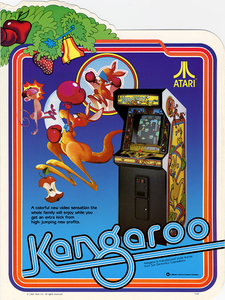
Kangaroo is a 1982 four-screen platform game released as an arcade video game by Sun Electronics and distributed in North America by Atari, Inc. Kangaroo is one of the first arcade games similar in style to Donkey Kong without being a direct clone. The player takes the role of a boxing glove-wearing mother kangaroo who is trying to rescue her joey from fruit-throwing monkeys. Jumping is integral to the game, but there is no jump button. Instead, the player pushes up on the joystick—or up and diagonally—to leap. The arcade version of Kangaroo has visible glitches in the graphics, such as sprites briefly flickering.

H.E.R.O. is a video game designed by John Van Ryzin and published by Activision for the Atari 2600 in March 1984. The game has players control Roderick Hero who traverses a mineshaft avoiding enemies and hazards to rescue trapped miners. He travels through the mines equipped with a hoverpack that allows him to traverse the game levels as well as bombs and laser that let him destroy walls and defeat enemies respectively.
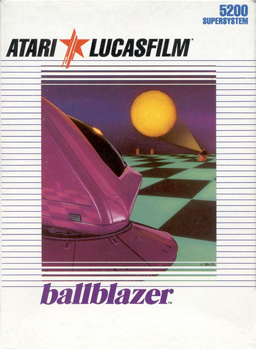
Ballblazer is a futuristic sports game created by Lucasfilm Games and published in 1985 by Epyx. Along with Rescue on Fractalus!, it was one of the initial pair of releases from Lucasfilm Games, Ballblazer was developed and first published for the Atari 8-bit computers. The principal creator and programmer was David Levine. The game was called Ballblaster during development; some pirated versions bear this name.
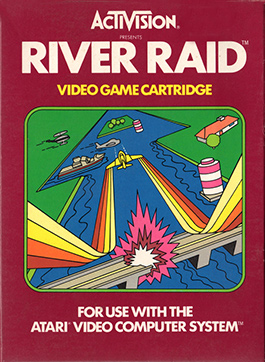
River Raid is a 1982 shoot 'em up video game developed and published by Activision for the Atari 2600. Designed by Carol Shaw, the player controls a fighter jet over the River of No Return in a raid behind enemy lines. The goal is to navigate the flight by destroying enemy tankers, helicopters, fuel depots and bridges without running out of fuel or crashing.
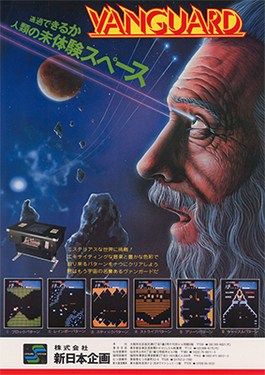
Vanguard is a scrolling shooter arcade video game developed by TOSE. It was released by SNK in Japan and Europe 1981, and licensed to Centuri for manufacture in North America in October and to Zaccaria in Italy the same year. Cinematronics converted the game to cocktail arcade cabinets in North America.
In the history of video games, the second-generation era refers to computer and video games, video game consoles, and handheld video game consoles available from 1976 to 1992. Notable platforms of the second generation include the Fairchild Channel F, Atari 2600, Intellivision, Odyssey 2, and ColecoVision. The generation began in November 1976 with the release of the Fairchild Channel F. This was followed by the Atari 2600 in 1977, Magnavox Odyssey² in 1978, Intellivision in 1980 and then the Emerson Arcadia 2001, ColecoVision, Atari 5200, and Vectrex, all in 1982. By the end of the era, there were over 15 different consoles. It coincided with, and was partly fuelled by, the golden age of arcade video games. This peak era of popularity and innovation for the medium resulted in many games for second generation home consoles being ports of arcade games. Space Invaders, the first "killer app" arcade game to be ported, was released in 1980 for the Atari 2600, though earlier Atari-published arcade games were ported to the 2600 previously. Coleco packaged Nintendo's Donkey Kong with the ColecoVision when it was released in August 1982.
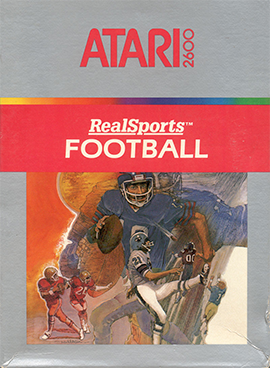
RealSports Football is a 1982 American football sports video game made by Atari, Inc. for the Atari 2600. Versions for the Atari 5200 and Atari 8-bit computers followed in 1983. It is part of the RealSports series of games.

Megamania is a fixed shooter video game developed by Steve Cartwright for the Atari 2600. It was published by Activision in 1982. In the game, a pilot of an intergalactic space cruiser has a nightmare where his ship is being attacked by food and household objects. Using the missile launcher from their space cruiser, the pilot fends off the attackers. The game was later released for the Atari 5200 and Atari 8-bit computers.

RealSports Tennis is a sports video game developed and published by Atari, Inc. for the Atari 2600, Atari 5200, and Atari 8-bit computers in 1983. It is part of the RealSports series of games.
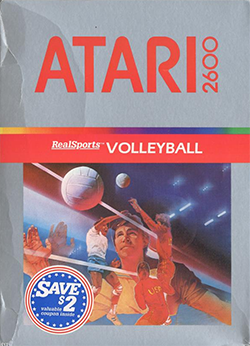
Realsports Volleyball is a volleyball video game written by Bob Polaro and Jim Huether for the Atari 2600 and published by Atari, Inc. in 1982. Polaro also programmed the Atari 2600 port of Defender.

Atari Vault is a video game collection developed by Code Mystics and published by Atari Interactive for Microsoft Windows, macOS, and Linux via the Steam client. Atari Vault contains titles from Atari, Inc. and Atari Corporation published on the Atari 2600 and arcade cabinets. dating from the 1970s, 1980s, and 1990s. The games, where possible, have been updated to include modern-day features such as local and online multiplayer and online leaderboards.

RealSports Baseball is a 1982 sports video game developed and published by Atari, Inc. originally for the Atari 2600. It was also launched on the Atari 5200 and 7800 machines. A version for the Atari 8-bit computers was in development, but cancelled.
RealSports is a series of sports video games originally developed and published Atari, Inc. The first games were released in 1982 for the Atari 2600, then the series expanded to the Atari 5200, Atari 7800, and Atari 8-bit computers. By the early 1980s, Atari's initial sports releases for the VCS — Home Run and Football — were dated in terms of visuals and gameplay, and targeted by an Intellivision ad campaign from Mattel. The RealSports series was an attempt by Atari to revitalize the sports game lineup for their consoles.

Atari 50: The Anniversary Celebration is a 2022 video game compilation and interactive documentary developed by Digital Eclipse and published by Atari to commemorate the company's 50th anniversary. It is composed of newly shot interviews with former Atari employees, archival footage, emulated games from the company's catalog, and six new games inspired by various Atari games. It was released for Atari VCS, Nintendo Switch, PlayStation 4, PlayStation 5, Windows, Xbox One, and Xbox Series X/S on November 11, 2022.


















